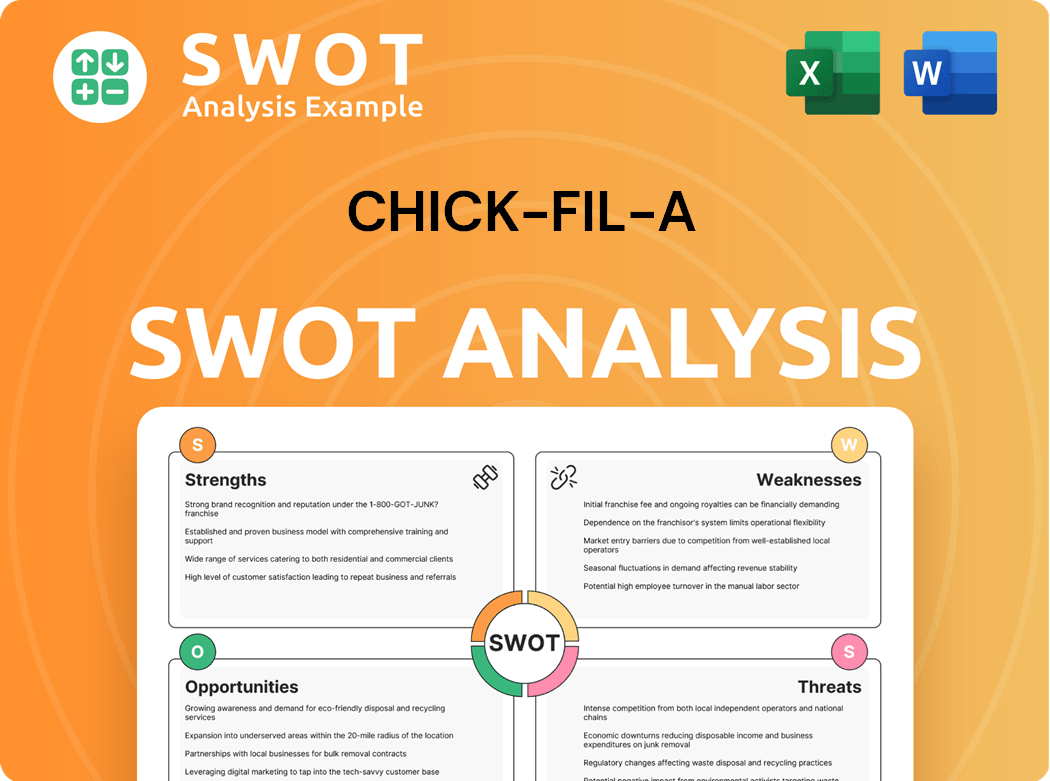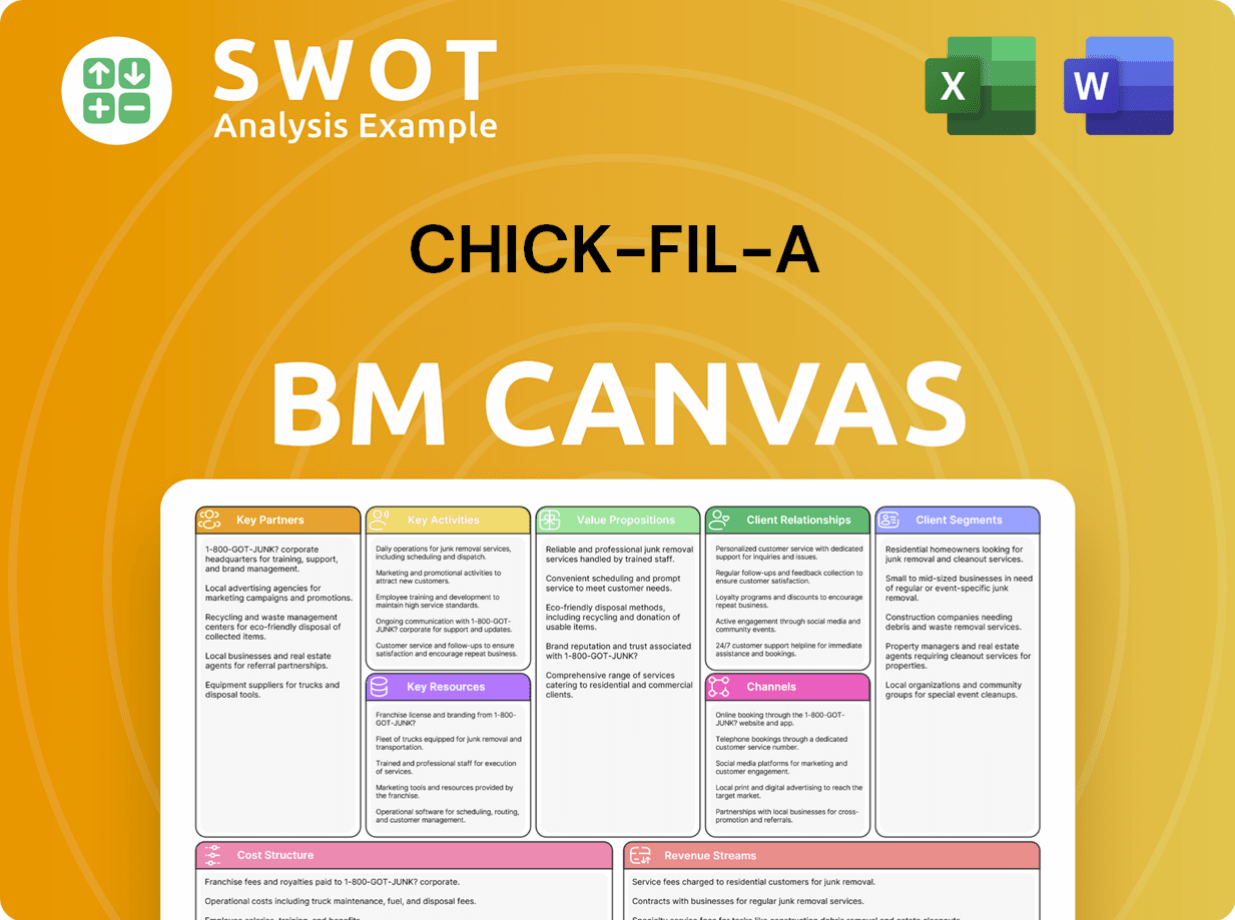Chick-fil-A Bundle
Can Chick-fil-A Maintain Its Reign in the Fast-Food Arena?
Chick-fil-A, the beloved chicken sandwich giant, has captivated the quick service restaurants (QSR) sector with its unwavering commitment to quality and customer service. From its inception as the Dwarf Grill, the company has defied industry norms and achieved remarkable success. But in the ever-evolving Chick-fil-A SWOT Analysis, how does this privately-held powerhouse navigate the intense Chick-fil-A competition?

This article will dissect the competitive landscape Chick-fil-A faces, exploring its key rivals and market positioning. We'll analyze the factors fueling its success, including its customer loyalty strategies and operational excellence, while also examining the challenges and opportunities ahead. Understanding the Chick-fil-A competitors is crucial for anyone looking to understand the dynamics of the fast food industry and the company's future growth potential.
Where Does Chick-fil-A’ Stand in the Current Market?
Within the competitive landscape of the fast food industry, Chick-fil-A holds a strong market position, especially in the chicken segment. The company's success is evident in its financial performance and operational strategies. In 2024, Chick-fil-A ranked as the third-largest quick-service chain in America by sales, demonstrating its significant presence in the restaurant market.
The company's core operations focus on providing high-quality, chicken-based meals. Its menu primarily features signature chicken sandwiches, nuggets, salads, and breakfast items. Chick-fil-A emphasizes hand-breaded and pressure-cooked chicken, which is a key differentiator. This commitment to quality and service has cultivated strong brand loyalty, allowing it to charge a slight premium over competitors.
Chick-fil-A's value proposition centers on offering exceptional customer service and high-quality food. This strategy has helped the company maintain a strong market position and achieve impressive financial results. For example, in 2024, domestic franchised restaurants (excluding mall locations) that had been open for at least a year reported a median annual sales volume of $9.227 million and an average annual sales volume of $9.317 million, significantly outperforming many rivals. To learn more about the company's origins, you can read a Brief History of Chick-fil-A.
Chick-fil-A's market share is substantial, driven by high sales per restaurant. In 2024, the company's average unit volumes across all locations were $7.4 million. This performance highlights its ability to generate significant revenue compared to competitors.
The company has a strong presence across the United States, with over 3,100 locations. Chick-fil-A is also expanding internationally, with planned entries into the U.K. in early 2025 and Singapore in late 2025, demonstrating its growth potential in the fast food market.
Chick-fil-A's financial health is robust, with steady revenue growth. Sales reached over $21.6 billion in 2023. Despite a slight slowdown in domestic sales growth to 5.4% in 2024, the company still added $1.2 billion in sales, outpacing many major fast-food chains.
The company's competitive advantages include its focus on high-quality food, exceptional customer service, and strong brand loyalty. These factors allow Chick-fil-A to maintain a premium pricing strategy and consistently outperform competitors in sales per restaurant.
Chick-fil-A differentiates itself through its focus on quality, customer service, and operational efficiency. These elements are crucial in the competitive landscape Chick-fil-A faces.
- Customer Service: Chick-fil-A is known for its exceptional customer service, which fosters brand loyalty.
- Product Quality: The emphasis on high-quality, hand-breaded chicken sets it apart from many competitors.
- Operational Efficiency: Despite closing on Sundays, Chick-fil-A consistently outperforms competitors in sales per restaurant.
- Strategic Expansion: The company's expansion into international markets like the U.K. and Singapore indicates its growth strategy.
Chick-fil-A SWOT Analysis
- Complete SWOT Breakdown
- Fully Customizable
- Editable in Excel & Word
- Professional Formatting
- Investor-Ready Format

Who Are the Main Competitors Challenging Chick-fil-A?
The fast-food industry is intensely competitive, and Chick-fil-A faces a complex competitive landscape. The company's success is constantly challenged by both direct and indirect competitors vying for market share. Understanding the key players and their strategies is crucial for assessing Chick-fil-A's position and future prospects.
Chick-fil-A competes with a variety of restaurants, from chicken-focused chains to larger, more diversified fast-food giants. These rivals employ different strategies, including menu innovation, pricing adjustments, and marketing campaigns, to attract and retain customers. The restaurant market analysis reveals a dynamic environment where adaptability and differentiation are essential for survival and growth.
Chick-fil-A's ability to maintain its market position depends on its ability to understand and respond to the strategies of its competitors. The company's focus on customer service, food quality, and operational efficiency is critical in this competitive landscape. This analysis explores the major players and their impact on Chick-fil-A's business.
Several chains specialize in chicken, posing direct competition to Chick-fil-A. These competitors focus on similar menu items, such as chicken sandwiches, nuggets, and tenders. They often compete on price, menu variety, and convenience.
KFC, a global fast-food chain, is a major competitor. KFC offers a wide variety of fried chicken products. KFC's global presence and brand recognition are significant, but Chick-fil-A often excels in customer service and per-store sales.
Popeyes is a direct competitor, especially with its popular chicken sandwich. The 'sandwich war' ignited by Popeyes in 2019 intensified competition in the chicken market. However, Chick-fil-A generally maintains an advantage in customer service and brand image.
Other notable competitors include Zaxby's, Raising Cane's Chicken Fingers, Church's Chicken, and Bojangles' Famous Chicken 'n Biscuits. These chains focus on specific chicken offerings and compete regionally or nationally. Their strategies vary, focusing on different aspects of the customer experience and menu.
Chick-fil-A also competes with larger, diversified fast-food chains. These companies have extensive resources, broad menus, and significant brand recognition. They often compete on value, convenience, and menu variety.
McDonald's, with a massive global presence, is a formidable competitor. McDonald's has been expanding its chicken offerings to directly compete with Chick-fil-A. McDonald's vast advertising budget and brand recognition provide a significant advantage.
Beyond direct competitors, Chick-fil-A faces indirect competition from other quick service restaurants and emerging players. These companies may not specialize in chicken but still compete for the same customer base. The fast-food industry is constantly evolving, with new entrants and strategic alliances reshaping the market.
- Wendy's: Wendy's offers chicken sandwiches and nuggets, competing directly with Chick-fil-A. Wendy's often positions its products as premium alternatives.
- Burger King: Burger King also provides chicken options, competing for market share.
- Subway: Subway, while known for sandwiches, also offers chicken-based menu items.
- Dave's Hot Chicken: Dave's Hot Chicken is expanding internationally, mirroring Chick-fil-A's entry into new markets, increasing the competition.
- Mergers and Alliances: The fast-food industry sees mergers and alliances that influence the competitive landscape.
Chick-fil-A PESTLE Analysis
- Covers All 6 PESTLE Categories
- No Research Needed – Save Hours of Work
- Built by Experts, Trusted by Consultants
- Instant Download, Ready to Use
- 100% Editable, Fully Customizable

What Gives Chick-fil-A a Competitive Edge Over Its Rivals?
The competitive landscape of the fast food industry is fiercely contested, with numerous players vying for market share. Understanding the competitive advantages of key players like Chick-fil-A is crucial for strategic analysis. Analyzing the Chick-fil-A competition requires a deep dive into its operational strategies, customer service models, and brand positioning, which have significantly influenced its success in the restaurant market analysis.
Chick-fil-A's sustained success is a testament to its effective strategies in the quick service restaurants sector. The company's focus on quality, customer experience, and employee satisfaction has allowed it to carve out a unique niche. This chapter aims to dissect the core elements that contribute to Chick-fil-A's competitive edge, offering insights into how it differentiates itself from Chick-fil-A competitors.
A comprehensive look at Chick-fil-A's biggest rivals in the US reveals that the company's strengths lie in its ability to maintain high standards across all aspects of its operations. This approach has not only fostered strong customer loyalty but also positioned it as a leader in customer satisfaction within the fast food industry.
Chick-fil-A is renowned for its outstanding customer service, a key differentiator in the fast food industry. Consistently ranked at the top for customer satisfaction, it earned an ACSI score of 83 out of 100 in 2024. The staff's friendly and attentive approach, including the use of phrases like 'my pleasure,' creates a positive dining experience that fosters loyalty.
The company's commitment to quality ingredients is another significant advantage. Chick-fil-A is known for its hand-breaded, pressure-cooked chicken made from all-natural, hormone-free chicken breast. This focus on quality allows the company to command a premium price point, attracting customers willing to pay extra for a superior product.
Chick-fil-A has built a strong brand equity through its unique company culture and values. The policy of closing on Sundays, commitment to ethical branding, and community involvement resonate with socially conscious consumers. This has cultivated a positive brand reputation, enhancing customer loyalty and trust.
Operational efficiencies, such as its dual drive-thru system and mobile ordering strategies, contribute to its competitive edge. These features streamline the ordering and pickup processes, enhancing convenience for customers. These advantages are continuously refined, supporting the company's market position.
Chick-fil-A's competitive advantages are multi-faceted, encompassing customer service, product quality, brand equity, and operational efficiency. These elements work together to create a sustainable edge in the quick service restaurants sector. The company's ability to maintain high standards across all these areas differentiates it significantly from its competitors.
- Customer Loyalty: Chick-fil-A's customer loyalty program, Chick-fil-A One, has over 50 million members, showcasing its effectiveness in retaining customers.
- Menu and Pricing: While its menu is focused, its pricing strategy supports its premium positioning, with items often priced slightly higher than competitors.
- Expansion and Growth: The company continues to expand, focusing on strategic locations and maintaining its high standards as it grows.
- Financial Performance: Analyzing Chick-fil-A's financial performance vs competitors reveals strong revenue growth and profitability, driven by its operational efficiencies and customer loyalty.
Chick-fil-A Business Model Canvas
- Complete 9-Block Business Model Canvas
- Effortlessly Communicate Your Business Strategy
- Investor-Ready BMC Format
- 100% Editable and Customizable
- Clear and Structured Layout

What Industry Trends Are Reshaping Chick-fil-A’s Competitive Landscape?
The fast-food industry is dynamic, with trends shaping the competitive landscape for companies like Chick-fil-A. Understanding these shifts is crucial for assessing its position, potential risks, and future outlook. The restaurant market analysis reveals a sector undergoing significant changes, driven by consumer preferences, technological advancements, and economic pressures.
Chick-fil-A faces both challenges and opportunities in this evolving environment. Its success hinges on adapting to consumer demands, leveraging technology, and navigating economic headwinds. A deep dive into its competitive advantages and strategic initiatives provides insights into its ability to maintain and grow its market share.
The fast food industry is seeing increased demand for healthier and plant-based options. Digital transformation through mobile ordering and delivery services is becoming essential. Inflationary pressures are impacting consumer behavior, with many viewing fast food as a luxury.
Increased competition from both established and emerging players poses a threat. Changes in supply chain practices, such as discontinuing the use of antibiotic-free chicken, could impact brand image. Maintaining value perception amid rising prices is critical for sustained success.
International expansion, with plans to invest $1 billion by 2025, presents significant growth potential. Leveraging strong brand loyalty and customer service remains a key advantage. Strategic menu innovation and market expansion will drive future success.
Chick-fil-A's primary competitors include McDonald's, Burger King, and Wendy's. The 'chicken sandwich wars' highlighted the rapid shifts in market share. The company's focus on quality and customer service differentiates it within the quick service restaurants sector.
Chick-fil-A's mobile app and loyalty program have been successful in driving sales. The company plans to open a record number of locations in Canada in 2025. The company's focus on customer service and product quality supports its premium pricing strategy.
- Chick-fil-A's customer loyalty strategies have been key to its success.
- The company's expansion strategy includes significant international growth.
- Menu innovation and adaptation to changing consumer preferences are ongoing.
- Investment in technology, such as mobile ordering, is critical for competitive advantage.
Chick-fil-A Porter's Five Forces Analysis
- Covers All 5 Competitive Forces in Detail
- Structured for Consultants, Students, and Founders
- 100% Editable in Microsoft Word & Excel
- Instant Digital Download – Use Immediately
- Compatible with Mac & PC – Fully Unlocked

Related Blogs
- What are Mission Vision & Core Values of Chick-fil-A Company?
- What is Growth Strategy and Future Prospects of Chick-fil-A Company?
- How Does Chick-fil-A Company Work?
- What is Sales and Marketing Strategy of Chick-fil-A Company?
- What is Brief History of Chick-fil-A Company?
- Who Owns Chick-fil-A Company?
- What is Customer Demographics and Target Market of Chick-fil-A Company?
Disclaimer
All information, articles, and product details provided on this website are for general informational and educational purposes only. We do not claim any ownership over, nor do we intend to infringe upon, any trademarks, copyrights, logos, brand names, or other intellectual property mentioned or depicted on this site. Such intellectual property remains the property of its respective owners, and any references here are made solely for identification or informational purposes, without implying any affiliation, endorsement, or partnership.
We make no representations or warranties, express or implied, regarding the accuracy, completeness, or suitability of any content or products presented. Nothing on this website should be construed as legal, tax, investment, financial, medical, or other professional advice. In addition, no part of this site—including articles or product references—constitutes a solicitation, recommendation, endorsement, advertisement, or offer to buy or sell any securities, franchises, or other financial instruments, particularly in jurisdictions where such activity would be unlawful.
All content is of a general nature and may not address the specific circumstances of any individual or entity. It is not a substitute for professional advice or services. Any actions you take based on the information provided here are strictly at your own risk. You accept full responsibility for any decisions or outcomes arising from your use of this website and agree to release us from any liability in connection with your use of, or reliance upon, the content or products found herein.